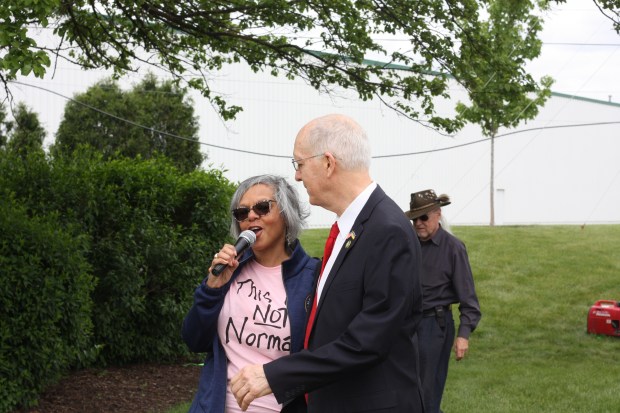Much like the memes already dedicated to them on social media, gobs of cicadas will be emerging soon.
The Lake County Forest Preserve District is celebrating the return of the 17-year periodical cicadas with a special exhibition. Celebrating Cicadas runs from April 27 to Aug. 4 at the Bess Bower Dunn Museum in Libertyville.
Every 17 years, billions of brood XIII cicadas emerge from the ground, ready to make some noise. In Lake County, they’re expected to show their beady red eyes in late May and early June, once the temperature of the upper 8 inches of soil reaches 64 degrees, said director of education Alyssa Firkus.
She’s excited to share the new exhibit with visitors, which will offer an opportunity to learn about the biology, behavior and ecological significance.
“It’s a hot spot for this emergence, especially in some of our really high-quality woodlands down in the southern part of the county, so we get these huge numbers of cicadas,” she said. “This is a few times in peoples’ lifetimes they get chance to see these cicadas emerge. We want to be the organization that people go to to learn about this amazing phenomenon.”
In addition to the 17-year cicadas, annual cicadas will make their trek up to the ground later this summer. Another set of periodical cicadas, the 13-year brood XIX cicadas, will emerge this summer too.
“This year is very special in Illinois. Because in Illinois, there is the 17-year-cicada … and there is the 13-year cicada emersion that’s happening in central and southern Illinois,” she said. “So the overlap isn’t in Lake County, but for Illinois specifically, this is a really amazing time. It only happens once every few lifetimes. They only sync up once every 221 years. It’s pretty incredible.”
This is the first time the emergence of the 17-year and the 13-year cicadas have coincided in Illinois since 1803.
“That’s when Thomas Jefferson was president of the United States,” she said. “And it won’t happen again until 2245.”
Mark your calendars.
“In Illinois, this is just a very big year,” she said. “In Lake County, there are so many great hot spots to see this emersion and expose the public to this amazing phenomenon.”
The exhibit is designed to educate guests about the lifecycle of the cicada, she said. From hatching as nymphs to living underground sucking sap for 17 years to finally emerging, guests will earn about the insect’s lifecycle.
“After they emerge, they become their adult form. They shed their exoskeleton and that’s when they get their wings and that’s when they start to sing,” Firkus said. “That whole lifecycle …17 years of their life is underground. And once they get their wings and they become an adult, they only live four to five weeks after that. It’s a very short life.”
Visitors will learn how to tell the difference between annual and periodical cicadas and will see where emergences are happening. The periodical cicadas that emerge in late May/early June have bright red eyes as compared to the black eyes of the annual cicadas that emerge later in the summer.
People will also learn how they can help the scientific community learn more about cicadas, she said.
“We are going to ask people to scan a QR code and if they see or hear any cicadas, to tell us where they saw them and if they can identify them,” she said. “We are trying to use the community to get as much data on where the cicadas are in our county.”
People will also get a chance to listen to the “song” of the cicadas, Firkus said.
“That’s one of the biggest things cicadas are known for – their vocalizations,
she said. “They make noise in a way that most insects don’t. Cicadas make noise kind of by using the hollow ends of their bodies. It’s an incredibly loud noise and when it’s synchronized it can be kind of overwhelming.”
People will also learn why cicadas are important and why they matter to the ecosystem. They’re a food source for other amphibians, reptiles, birds and other insects and when they die and decompose, their nitrogen-rich bodies provide nutrients for the soil, she said.
“Yes, they’re loud and yes, there are a lot of them, but there are benefits and they are part of the ecosystem,” she said. “They don’t hurt humans. They don’t bite. They’re not toxic. They’re very harmless to people and pets.”
Cicada specimens from the Field Museum dating back to 1939 will be displayed.
To design an entire exhibit over an insect that’s an inch and a half long has been fascinating, she said. They worked experts and entomologists to create the exhibit, she said.
“It’s been a collaborative effort,” she said.
Samantha Gallagher, a Lake County freelance illustrator, was commissioned to help illustrate the exhibition.
Firkus is very excited to get guests in the doors and learn more about these unique creatures.
“Instead of being scared and worried about the emergence of the cicadas, we want to bring a whole different light to it,” she said. “We want people to celebrate this phenomenon with us.”
Annie Alleman is a freelance reporter for the News-Sun.
Celebrating Cicadas
Where: 10 a.m.-4:30 p.m. Tuesday, Thursday, Saturday and 12-4:30 p.m. Sunday April 27-Aug. 4
Where: Bess Bower Dunn Museum of Lake County, 1899 W. Winchester Road, Libertyville
Tickets: $3-$10; children 3 and under free
Information: 847-968-3400; lcfpd.org/cicada-symphony



